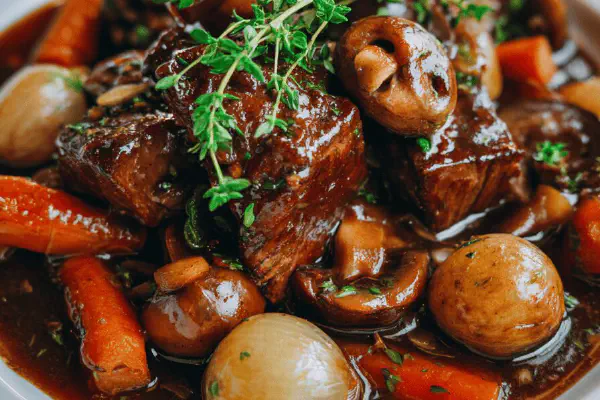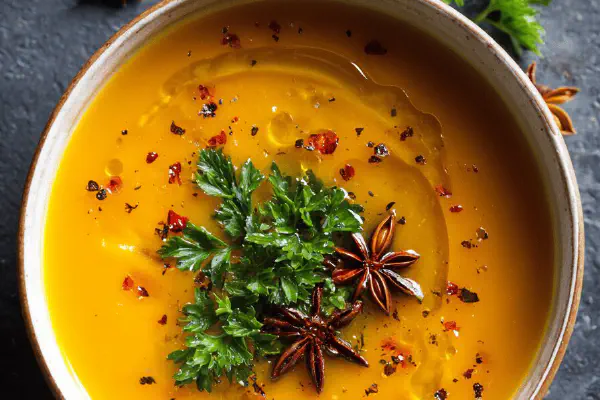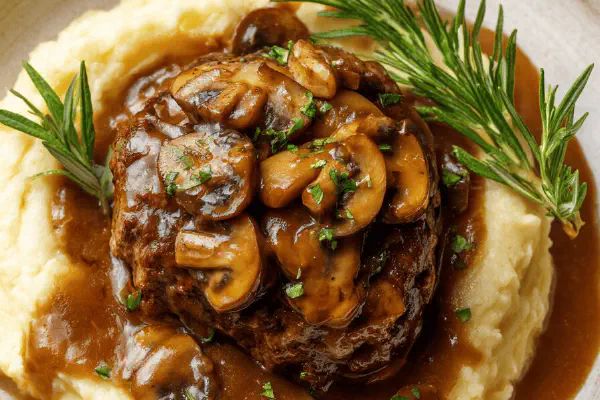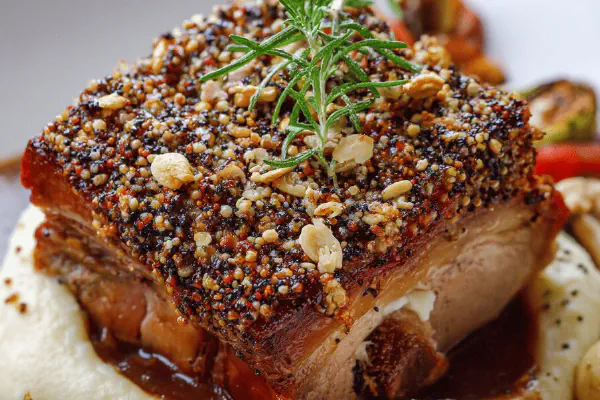Seitan Bourguignon Twist

By Emma
Certified Culinary Professional
Ingredients
- 750 g seitan, cut in 1 cm cubes, floured lightly
- 15 ml sunflower oil
- 25 ml unsalted butter (sub olive oil for dairy-free)
- Salt and freshly ground black pepper
- 3 garlic cloves, finely chopped
- 150 ml thinly sliced shallot (sub for white leek, sharper)
- 120 ml celery diced
- 480 ml (2 cups) diced carrots, peeled
- 375 ml dry red wine (cabernet or pinot noir, avoid overpowering)
- 400 ml vegetable broth
- 5 ml brown miso paste
- 1 sprig fresh thyme
- 1 bay leaf
Glazed Onions
- 24 pearl onions (pickled or fresh small), outer skins removed
- 125 ml water
- 15 ml sugar
Mushrooms
- 227 g cremini mushrooms quartered (deeper flavor than button)
- 15 ml butter or oil
- 15 ml chopped flat-leaf parsley
About the ingredients
Method
Browning Seitan and Veggies
- Dust seitan cubes with flour. Get pan smoking hot before oil and butter in. Aim for even browning; no overcrowding or it steams. Crisp crust signals flavor locked in. Salt and pepper here—season early to draw moisture and also flavor the crust. When seitan’s golden and almost crunchy edges show, pull out. Rest to avoid soggy.
- Same pan—add rest of butter. Toss garlic, shallot, celery, carrots in. Stir for 3-4 minutes. Smell has to open up, veggies softening. Salt and pepper at this stage enhances their natural sweetness. Watch garlic don’t burn, it turns bitter fast.
- Return seitan to pot. Deglaze with wine: pour slow, scrape brown bits from bottom. That’s your base. Then broth, miso paste (stir till dissolved), thyme, bay leaf. Season again lightly; broth or wine vary in salt. Bring just to boil.
- Cover pot. Simmer 35-40 minutes. Watch carrots; test with fork, want tender but not mushy. Stir occasionally to avoid sticking. Sauce will thicken slight, smell deepening, wine mellowing to soft tannins.
Glazed Onions
- Blanch pearl onions in boiling water ~30 sec. Shock in ice water, peel skins slip off easy. Small trick that saves time.
- Melt butter gently in sautée pan, add water, sugar, and onions. Simmer on very low for 15-18 minutes until water evaporates and onions look translucent, shiny like little jewels. Salt and pepper here sharpen sweetness.
Mushrooms
- Heat butter or oil hot in skillet. Mushrooms in single layer. Don’t crowd—crowding releases water, they stew instead of brown. Salt once side is golden, flip carefully. Repeat until all browned nicely. Reserve.
- Last step: to stew add glazed onions, mushrooms, stir in fresh parsley off heat. Stirring too long breaks texture.
- Serve warm, ladled over mashed potatoes or crusty bread.
- You’ll know stew is done when seitan bites tender yet retain chew, carrots yield without losing shape, and sauce is glossy without being watery or gluey.
- Smoky paprika addition: optional twist to add with garlic stage for layered warmth. Use sparingly; a little goes a long way.
- Alternative miso: use tamari for saltiness or skip if hypersensitive to soy. Adjust salt accordingly.
- If wine too bitter or overpowering, add splash of maple syrup or balsamic vinegar to balance acid and round flavor.
- Don’t rush browning. Skip seitan crust and texture flattens.
- Reserve seitan cooking oil to sauté mushrooms for extra flavor.
- If tired of pearl onions peeling, frozen pearl onions are decent substitute; thaw before glazing.
Cooking tips
Chef's notes
- 💡 Flour dusting seitan crucial. Too much powder clumpy crust. Pan must be hot, almost smoking. Oil and butter mix for browning richness. No crowding seitan cubes or they steam, lose crisp edges. The sizzle is your timer. Pull seitan when golden, edges almost crunchy but inside still chewy. Let rest or crust soggy, ruins texture entirely.
- 💡 Handling pearl onions tricky if peeling raw. Blanch in boiling water thirty seconds then shock ice bath. Skins slip slippery off—less frustrating. Simmer onions gently in butter, water, sugar until water gone and onions look translucent, shiny, small jewels. Low heat needed. Salt at glazing stage sharpens sweetness balance. Rushing burns sugar, tough skins remain a problem.
- 💡 Don’t rush sauté garlic or shallots. Garlic can burn quick, turns bitter, so keep gentle sizzle, garlic just softens. Shallot replaces leek here; sharper bite, stronger aromatics. Celery and carrots diced evenly for uniform tenderness—check carrots mid-simmer by fork; they should be tender but hold shape—no mush. Stir carefully, too vigorous breaks seitan texture.
- 💡 Deglazing pan after seitan browning important. Pour red wine slow, scrape browned bits—fond is flavor base here. Use moderate tannin reds, cabernet or pinot noir but avoid bitter or overpowering varieties. If wine too harsh, splash maple syrup or balsamic vinegar to balance acid and round flavors quietly. Miso paste adds umami depth- brown preferred but tamari or skipping are valid options.
- 💡 Mushrooms need space and high heat. Crowding releases water, they stew, no brown crust. Single layer in hot butter or oil. Salt when underside golden before flipping. Repeating browning batches intensifies flavor and prevents soggy mush. Reserve mushroom pan fat from seitan cooking for added depth. Fresh parsley stirred in off heat finishes with freshness and lifts heaviness.
Common questions
How to avoid soggy seitan?
Dry dust flour evenly. Hot pan, no crowding crucial. Listen for strong sizzle. Pull when golden edges appear. Rest seitan cubes off heat. Moisture off seitan surface kills crust, so dry cubes before flouring.
Can I skip pearl onions?
Frozen pearl onions work fine—thaw fully before glazing else water ruins glaze. Otherwise small shallots diced finer but lacks texture punch. Peeled fresh onions blanch to speed skins off, helps hands stay clean, less peeling hassle.
What if wine tastes bitter?
Add splash maple syrup or balsamic vinegar. Balances harsh acid, rounds flavor softly. Avoid overly tannic red wines from start. Can substitute with veggie broth if no alcohol, but loses some sharpness. Taste test early before adding broth fully.
Best way to store leftovers?
Refrigerate airtight up to 3 days. Reheat slowly on low heat to avoid seitan drying out. Freeze in sealed containers up to 2 months. Thaw overnight in fridge to maintain texture. Avoid microwave reheating too aggressively, breaks sauce gloss and crust texture.



